Davao City
| Davao City Dakbayan sa Dabaw Lungsod ng Dabaw |
|||
|
|||
| Motto: "Love, Peace, and Progress" | |||
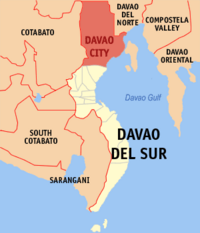 |
|||
| Country | Philippines | ||
|---|---|---|---|
| Region | Davao Region (Region XI) | ||
| Province | None | ||
| Districts | 1st to 3rd Districts of Davao City | ||
| Barangays | 184 | ||
| Incorporated (town) | 1848 | ||
| Incorporated (city) | October 16, 1936 | ||
| Government | |||
| - Mayor | Rodrigo Duterte (Hugpong/PDP-Laban) (2007-2010) | ||
| - Vice Mayor | Sara Duterte (Hugpong/PDP-Laban) (2007-2010) | ||
| Area | |||
| - Total | 2,444 km² (943.6 sq mi) | ||
| Elevation | 22.3 m (73 ft) | ||
| Population (2007) | |||
| - Total | 1,363,337 | ||
| - Density | 558/km² (1,445.2/sq mi) | ||
| Time zone | PST (UTC+8) | ||
| Area code(s) | 082 | ||
| Website: ''www.davaocity.gov.ph | |||
The City of Davao (Tagalog: Lungsod ng Dabaw; Cebuano: Dakbayan sa Dabaw) is the largest city on the island of Mindanao in the Philippines, the country's largest city in terms of land area, occupying 2,444 square kilometers (recently the city of Puerto Princesa with a total land area of 2,539 square kilometers has been disputing this title). It is also one of the Philippines' most progressive cities. Its international airport and seaport are among the busiest cargo hubs in the southern Philippines.
Davao City is also one of several cities in the Philippines that are independent of any province, though it is usually grouped with Davao del Sur for statistical purposes. The city is also the regional center for Davao Region (Region XI). Davao City has a population of 1,650,337 (2007 census). Metro Davao can also be dubbed as The City of Royalties or The Royal City, because of the presence of the kings and queens of the nature present in Davao. The Queen of Philippine Orchids which is Waling-waling, the King of Exotic Fruits, which is Durian, The King and Grandfather of Philippine mountains, Mt. Apo, the largest eagle in the world and the King of Philippine skies which is the Philippine Eagle, and the City itself which is one of the largest cities in the world in terms of land area.
In recent years, the sprawling urban Metropolis of Davao has emerged as the business, investment and tourism hub for the entire southern Philippines. The city boasts of some of the finest beaches and mountain resorts in the country, and proximity to the Philippines’ most captivating diving spots as well as its highest peak, Mount Apo.
Asiaweek ranked Metro Davao among the 20 Most Livable Cities in Asia, above Metro Manila and Metro Cebu and the number one as the most livable city in the country. Foreign Direct Investment Magazine conducted a study which named Davao City as the 10th "Asian City of the Future".
Metropolitan Davao
Metropolitan Davao is one of the three recognized Metro areas in the Philippines together with Metro Manila and Metro Cebu. Metro Davao comprises the following cities and municipalities: Davao City, Tagum City, Panabo City, Island Garden City of Samal, Digos City, and the Municipalities of Carmen and Sta. Cruz.
Contents |
History
Local historians claim that the word davao came from the phonetic blending of the word of three Bagobo subgroups when referring to Davao River, an essential waterway which empties itself into Davao Gulf near the city. The aboriginal Obos who inhabit the hinterlands of the region called the river, Davoh; the Clatta or Guiangans called it Duhwow, or Davau, and the Tagabawa Bagobos, Dabu. To the Obos, the word davoh also means a place "beyond the high grounds", alluding to the settlements located at the mouth of Davao River which were surrounded by high rolling hills. When asked where they were going, the usual reply is davoh, while pointing towards the direction of the town. Duhwow also refers to a trading settlement where they barter their forest goods in exchange for salt or other commodities.
Spanish influence was hardly felt in the Davao until 1848, when an expedition led by Don Jose Oyanguren came to establish a Christian settlement in an area of mangrove swamps that is now Bolton Riverside. Davao was then ruled by a Muslim chieftain, Datu Bago, who held his settlement at the banks of Davao River (once called Tagloc River by the Bagobos). After Uyanguren defeated Datu Bago, he renamed the region Nueva Guipúzcoa, in honor of his home in Spain, and became its first governor. Oyanguren's efforts to develop the area, however, did not prosper.
A few years after the American forces landed in 1900, private farm ownership grew and transportation and communication facilities were improved, thus paving the way for the region's economic growth.
A Japanese entrepreneur named Kichisaburo Ohta was granted permission to exploit vast territories which he transformed into abacá and coconut plantations. The first wave of Japanese plantation workers came onto its shores in 1903, creating a Little Japan. They had their own school, newspapers, an embassy, and even a Shinto Shrine. On the whole, they established extensive abaca plantations around the shores of Davao Gulf and developed large-scale commercial interests such as copra, timber, fishing and import-export trading. Filipinos learned the techniques of improved cultivation from the Japanese so that ultimately, agriculture became the lifeblood of the province's economic prosperity.
Davao was formally inaugurated as a chartered city on March 1, 1937 by President Manuel L. Quezon. Thirty years later, Davao was subdivided into three independent provinces, namely Davao del Norte, Davao del Sur, and Davao Oriental. Over the years, Davao has become an ethnic melting pot as it continues to draw migrants from all over the country, lured by the prospects of striking it rich in the country's third largest city.
In December 8, 1941 the attack of the Japanese planes bombed in Davao city.
In 1942, the Japanese troops occupied in Davao city.
In 1945, beginning the American and the Philippine Commonwealth forces liberated in Davao city attack by the Japanese forces during World War II.
Culture and Heritage
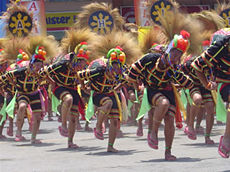
.
Easy assimilation is an integral essence of multi-cultural Davao. Being a chartered city, it has grown appreciating differences in culture and tradition by numerous ethnic groups that integrated easily to the local tribes already present during its infancy as a city.
Like most cities in the country, Catholics largely populate Davao. Christian churches and chapels dot the city’s landscape along with some temples, mosques, and other places of worship.
Another Spanish influence that remains up to this day is the observance and celebration of barrios (or villages) of the day of their respective patron saint called “Fiesta”. It is in these celebrations wherein songs, dances and other forms of arts and merrymaking from various cultures have evolved creatively into the sights and sounds of Davao now. Such showcases point to its ultimate climax as the celebration of all celebrations - the weeklong Kadayawan sa Dabaw Festival.
Geography and Physical Characteristics

The land area of Davao City is 2,443.61 square kilometers. In terms of land area, it is considered as one of the largest cities in the world. It is divided into 3 congressional districts, which are further divided into 11 administrative districts containing a total of 184 barangays. Almost 50% of its total land area is classified as timberland or forest. Agriculture utilizes about 43%. This is reflective of the fact that agriculture is still the largest economic sector. Big plantations that produce banana, pineapple, coffee, and coconut eat up a large chunk of the total land area.
Location
Approximately 588 statute miles southeast of Manila and 241 statute miles to Cebu City.
Traveling by sea, its location from Manila and Cebu is 971 and 593 nautical miles respectively.
It is the capital of the Davao Region and is the biggest urban Market in the growth polygon called BIMP-EAGA (Brunei-Indonesia-Malaysia-Philippines East Asian Growth Area)
Presently, built-up areas used for residential, institutional, commercial, and industrial purposes represent about 10% of the total land area. Under the approved land use plan built-up and settlement area will cover 15% of the total area while agricultural will be maximized with 67.19%. The remaining 17.68 will be devoted for forest and conservation.
Climate
Davao City is typhoon-free. The city enjoys a weather that remains balmy all year round. It is characterized by a uniform distribution of rainfall, temperature, humidity, and air pressure. It has no pronounced wet or dry season. Weather predictability makes it highly conducive to agricultural production. Temperature ranges from 20 to 32 degrees Celsius and average rainfall is up to 2,000 mm yearly.
Language
Cebuano is the most widely spoken language in the city, while Tagalog comes a distant second. Bisalog, an informal mixing of the above languages, is spoken as well. Japanese is spoken by the Japanese Filipino community and Chinese is spoken by the Chinese Filipino population. This fusion though is not generally held acceptable in any formal level. English is the medium of instruction in schools and is widely understood and spoken especially in the business community and also for all official documents.
Religion
The most dominant group is the Roman Catholic at 83.83%, other Christian groups comprise 15% and the remaining 1.17% belongs to other non-Christian faiths (Islam, Buddhism, etc)
Accessibility
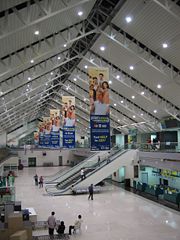
.
Davao City is very accessible and is the gateway to BIMP-EAGA.
By land
Like most of the cities in the Philippines, there is an abundance of buses, jeepneys, taxicabs and tricycle which makes getting around the city quite easier.
By sea
The city is also served by passenger ferries throughout the Philippines.
- Sulpicio Lines twice weekly from Manila.
- SuperFerry twice weekly to Manila.
By air
Davao City is served by Francisco Bangoy International Airport (Davao International Airport). DIA is currently served by the following carriers:
- Air Philippines Twice daily flights to Cebu and once daily flight Manila.
- Cebu Pacific Regular flights to Cebu, Iloilo, Manila and Zamboanga.
- Philippine Airlines 7x daily flights to Manila.
- PAL Express Once daily flight to Zamboanga
- SilkAir Daily flights to Singapore.
New Destinations from Davao International Airport
- Cebu Pacific Regular flights to Hongkong (begins November 5, 2008) and to Singapore (begins November 4, 2008.)
- Zest Airways Once daily flight to Cebu (begins December 20, 2008.)
Economy

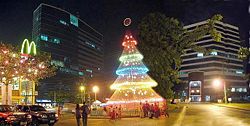
Davao City is the "Crown Jewel" of Mindanao in terms of economic activity. It is the single most important economy in the island, being the third biggest metropolitan area in the country next only to Manila and Cebu.
Like the rest of the country, Davao City operates on an economic system that is market-oriented, although pricing mechanisms remain regulated in a few sectors (particularly on basic commodities) to protect consumers. The competitiveness of the market has been enhanced through the dismantling of protection for "infant industries" and the breakdown of industries with monopolistic or cartel tendencies.
On the international front, the economy has been opened up to global competition, through a tariff reduction program and the loosening of restrictions on inward foreign investment. The result is a diverse economy, featuring a sound mix between the agricultural (roughly 45%), industrial (15%) and service (at around 35%) industries. Poverty reduction has become the main goal of the local government which is being addressed through programs and projects one of which is the encouragement of inward investments to industries that are labor-intensive.
Fortunately for Davao, private investments has Davao City’s economy is steadily growing in the last two decades. The City has shifted counting investments from millions in the 80s to billions in the 90s and up to the present millennium. Among Asian cities, Davao has maintained its competitive position in attracting investments and in penetrating new foreign markets owing to its resilient exports base, peaceful business climate, better quality of life, and rich pool of skilled workforce. With over 1.2-Million people as primary market base, the city is conducive to business as evidenced by the presence of the country’s top 200 companies. Inflow of investments has been remarkable in the last ten years. Export in the City is now billion dollar industry with a growing niche market for its products. The stable banana and flourishing pineapple industries are among the country’s leading export commodities. A net exporter since 1987, Davao City largely contributed in making the Philippines as the world’s top 3 banana exporter. Primarily an agricultural area, almost all kinds of fruits thrive in Davao including the exotic Durian. Other major agriculture-based exports are pomelo, mango, coconut, papaya, mangoosten, and even flowers.
The productive linkages between established businesses and Davao City community reinforced the competitive quality of life in a city that has consistently maintained single digit inflation rate since 1993. Along with flourishing investments and exports, the low inflation rate serve as concrete illustration of the remarkable gains from Davao City’s sustained competitiveness nurtured by high level of responsiveness of the local government which put priority focus in facilitating business-friendly initiatives and in ensuring a peaceful and prosperous environment.
Government
Unique to the local government set-up of the city is the designation of a deputy mayor by the city mayor. Although an appointed official only, the deputy mayor serves as a direct link to the city mayor, especially for people living outside the city proper. The deputy mayor also serves as the city mayor's representative in community events. The functions of the position are considered complementary to the functions of the city vice-mayor, given the large territorial jurisdiction of the city.
The city is politically subdivided into 184 barangays.
The current mayor of Davao City is Rodrigo Duterte, a former government prosecutor and congressman. He is assisted by city vice-mayor Sara Duterte, his daughter.
The City Government of Davao is now proposing to add two more Congressional Districts.
Security and Civil Defense
The city government has invested millions of pesos to ensure the security of people living and working in Davao City. Aside from the usual forces of the Philippine National Police, a special military task force has been formed to insulate the city from terrorist attacks and other forms of criminality. The Task Force Davao, as it is named, is affiliated with the Philippine Army and is headed by an army colonel.
The city government also maintains a 24-hour emergency response system patterned after the 9-1-1 systems in Canada and the United States. People can dial the 911 number to report emergencies and criminal incidents.
A curfew on minors is also observed in the city. All business establishments, in particular bars and discos, are mandated by a city ordinance to refrain from selling alcoholic drinks beyond 2:00 AM. Also, motorcycle drivers with no helmets and motorists with defective lights are not allowed to enter or drive in the city. Regular checkpoints in key parts of Davao City and at the city boundaries are conducted 24 hours to ensure the strict implementation of traffic rules.
The use of fireworks and other similar pyrotechnics, as well as smoking, is strictly prohibited in most of the city. Even outdoors, if you are under a roof of any kind, you are prohibited from smoking. Violators are made to pay hefty fines, perform community service, serve jail time, or a combination of the three. Littering is also prohibited.
Foreign Relations
The influx of foreign visitors and the presence of expatriates and migrants in the city have prompted the governments of Japan, Malaysia, Indonesia and the United States to open consular offices in the city.
The US Embassy in the Philippines opened a virtual consulate where inquiries regarding visa issuances, foreign relations concerns and travel to the United States can be made on the Internet by e-mail and chat. The virtual consulate website [1] is maintained in coordination with Ateneo de Davao University and Holy Cross of Davao College.
Physical Infrastructure

The presence of basic infrastructure within the city such as airport, seaports, roads, bridges, telecommunications, condominiums, malls and first class hotels has sustained the economic growth in the last 10 years. Due to the city’s unprecedented growth, a clamor for higher capacity infrastructures resulted to a number of modernization projects now ongoing to meet the demands of the new millennium.
Airport
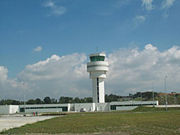
.
The Francisco Bangoy International Airport (Davao International Airport) is the busiest airport in Mindanao. Expansion and modernization began in 1998. Today, the new DIA (opened in December 2003) has begun accommodating wider-bodied jets such as the Boeing 747, the Airbus A340 and the Airbus A330.
Roads and Bridges
Construction of more roads and bridges are also underway. The construction of the City’s third major road - the Buhangin underpass was completed in the 1st quarter of 2003. A Traffic Management and Computerization Scheme was also implemented. Davao City is ranked no. 5 among cities in Asia with better traffic flow based on vehicles per kilometer of city road.
Seaports
Davao City and the Port of Davao has 2 government international seaports in (the Sasa Wharf and the Sta. Ana Wharf) and 9 privately owned ports. In addition, the Toril international Fish Port Complex accommodates small and large-scale fishing activities as well as provide among others cold-storage facilities.
Telecommunications
Communication links within the key business areas are adequate. With the deregulation and privatization policies of the Philippine government, the number of telecommunications player is projected to increase as well as offer affordable telecommunications services to subscribers/clienteles.
Internet Service Providers
There are 6 Internet Service Providers operating in Davao City offering dial-up, dedicated and DSL types of service. The City has over a hundred Internet cafés operating in strategic areas where one can surf, chat, play games, send and view e-mails, and engage in e-commerce using the latest computer innovation and technology.And soon new service provider Sulubit.
Tourism

Tourists' Spots
- Battle Memorial -– A historical marker of the longest-fought battle between the troops of the American & Filipino forces and of the Japanese Imperial Army which took place in Mintal, Tugbok District. (Mintal Elementary School)
- Camp Domingo Leonor -– Quarters of the Spanish and later American soldiers in the 1920s. (San Pedro St.)
- City Hall of Davao –- The former municipal building constructed in 1926. (San Pedro St.)
- Crocodile Farm –- The only crocodile park in the region provides home to locally bred crocodiles including the country's biggest crocodile named Pangil (or fangs) measuring over 18 feet in length. One can take pleasure from viewing, horseback riding around the park, or feeding the young fierce reptiles.
- Davao Museum -– Houses artifacts of Davao's indigenous tribes and photographs of the city's historic events and history of its pioneering families. (Insular Village I, Lanang)
- Davao Historical Society Museum -– Features the historical and indigenous collections of the Davao Historical Society (Magsaysay Park)
- Fort of Datu Bago -- Site of the bastion of the Muslim hero Datu Bago who lorded over the Tagloc River, the old name of Davao River. (Junction of Washington St. and Quimpo Blvd.)
- Furukawa Plantation -– The abaca plantation in Daliao which was acquired from the Bagobos as a result of the Otha Public Land Act in 1903. (Toril)
- Gap Farm -– The GAP Farm has deluxe cottages and campsites, Olympic size swimming pool, picnic area, horseback riding facilities, convention hall, and a World War II cave among others. Its garden is filled with exotic flowers and tropical fruits. Located in Barangay Ma-a.
- Japanese Museum –- The museum features historical accounts of the Japanese community residing in Davao before and during the war including their tools which they used in the abaca plantations, currencies, publications, among others. (Calinan)
- Japanese Peace Memorial Shrine -– During the "Ubon Yasumi, " Japan's version of All Souls' Day held in August, Japanese war veterans and their kin take a pilgrimage to visit this memorial shrine. (Mintal)
- Japanese Tunnel -- A restaurant with a free entry to a tunnel that the Japanese created in the time of the Japanese Revolution. (Matina)
- Lon Wa Buddhist Temple -- The biggest Buddhist temple in Mindanao is set in environment of candle trees and bamboo with an imposing statue of the Buddha and his life depicted in wood carving. (R. Cabaguio Ave.)
- Memorial to a Brave Son -- This memorial marker was built in recognition of the gallantry of Armando Generoso, who died in the very site of the bridge while defending it from the Japanese invaders during World War ll. (Gov. Generoso Bridge)
- Mindanao Taoist Temple –- Houses the holy icons of the Taoist religion. (J.P. Cabaguio Ave.)
- Mintal Historical Marker -– A memorial to Col. Yamada who defended Mintal during the war. It is also the site of the visit of McArthur, Stillwel and Eichelberger. (Mintal)
- Monument of Peace & Unity -– Unveiled during the celebration of the Philippine Centennial in 1998, the monument depicts the peaceful relationship of the migrant and indigenous inhabitants of Davao in the last 100 years. (San Pedro St.)
- Mosques -– Islam is also one of the major religions in the city with several places of worships found in Bankerohan, Quezon Blvd., Panacan, Quimpo Blvd., among others.
- Museo Dabawenyo -– a government owned museum located at cor. pichon st and claveria st.
- Old Japanese Houses -– The site of old Japanese homes, warehouses and abaca processing and drying plants before and during World War II. (Mintal, Tugbok District & Toril District)
- Osmeña Park -– Formerly known as the Plaza, this was the site of the settlement of the early Davaoeños. (San Pedro St.)
- Ottha Kyosaburu Memorial Shrine -– A memorial obelisk built in honor of Otha Kyosaburu who invoked the Public Land Act No. 926 of 1903. (Mintal Elementary School)
- Uyanguren Landing Site -– The landing site of Don Jose Oyanguren y Cruz of Guipuzcoa, Spain, the Spanish conqueror who later became the Governor of Davao. (Rodriguez Park, Quezon Blvd.)
- San Pedro Cathedral –- One of the oldest churches in Mindanao, the original structure of the church was built in 1847 in honor of St. Peter, the city's patron saint. The old altar is preserved at the right wing of the cathedral. (San Pedro St.). It is the ecclesiastical seat of the Archdiocese of Davao.
- Shrine of the Holy Infant Jesus of Prague -– A local mecca of the city's Roman Catholic devotees. (Shrine Hills, Matina)
- St. Mary of Perpetual Rosary -– A shrine built in honor of the Blessed Virgin Mary which features series of steps which leads to the main chapel. (Cabantian, Buhangin District)
- Talomo Beach –- Sunken warships during the Second World War can be found just 200 meters from the shore. (Talomo District)
- Eden Nature Park -- A very popular mountain resort located in Eden, Toril District, some 40 min away from the city center. It is situated 3000 ft above sea level, giving it a cool and moderate climate. It is 95% man made with pine trees dotting the landscape. It covers 40 hectares worth of developed land.
- Philippine Eagle Center -- Home to the Philippines National Bird, The Philippine Eagle (previously named Monkey Eating Eagle), the largest eagle in the World. It is where they are bred in captivity in order to increase their population and prevent extinction. Located in Malagos, a 45 min drive from the city center. Aside from being a temporary home for the Monkey Eating Eagle's, it also hosts some other exotic animals native to Davao's forest.
- Paradise Island and Beach Resort -- A very popular white sand beach resort located in Samal Island. It is a 5 min boat ride away from its drop off point at Lanang. Aside from its unspoiled waters, it also has a zoo as an added attraction.
- People's Park -- On December 15, 2007, Mayor Rodrigo Duterte led local officials in opening the P 72-M People’s Park (old PTA Ground) in Davao City, which features a mini-forest and large sculptures representing indigenous groups in Southern Mindanao.[1]
Shopping Centers and Malls
- Aldevinco Shopping Center - C.M. Recto Avenue
- Chimes Mall - Sales St., Chinatown
- City Triangle - C.M. Recto Avenue
- DAMOSA Market Basket - J.P. Laurel Avenue, Lanang
- Davao Central Warehouse Club - Agdao, Bajada
- Felcris Department Stores - Ilustre and Chinatown
- Gaisano Mall of Davao - J.P Laurel Avenue, Bajada
- Gaisano Grand Citimall - Ilustre Street
- Lachmi Mall - San Pedro Street
- NCCC Mall Davao - corner McArthur Highway and Ma-a road
- NCCC Mall (Main)- R. Magsaysay Avenue, Chinatown
- NCCC Centerpoint - Mac Arthur Hi-way, Matina
- SM City Davao - Quimpo Boulevard
- Victoria Plaza Mall - J.P Laurel Avenue, Bajada
Socio-cultural Environment
Health and Hospital
The average life expectancy of Davaoeños is 70 for females and 65 for males. There are about 31 hospitals with a total of 1,963 beds in Davao City. Very affordable medical services are made available to poor residents through the Davao Medical Center, which has the most hospitals beds at 600.
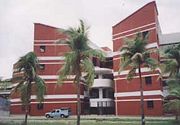
On the other hand, hospitals such as the Davao Doctors Hospital, San Pedro Hospital, Brokenshire Memorial Hospital, Ricardo Limso Medical Center, and Davao Medical Center are training hospitals that also offer specialized medical care services. Davao Regional Hospital in neighboring Tagum City, also offers the same quality specialized physician training and health services.
Psychiatric hospitals, psychotherapy clinics and counselling centers are also found in the city, directed and manned by internationally-trained counselors, psychologists, psychometricians and psychiatrists.
In Davao City, there are currently six large tertiary hospitals: Davao Doctors Hospital, San Pedro Hospital, Brokenshire Memorial Hospital, Davao Medical School Foundation Hospital, Ricardo Limso Medical Center, and Davao Medical Center.
Education

.
The government provides free education at the primary (grade school) and secondary (high school) levels. Government scholars from all over the island enjoy free college education in state-run universities such as the University of the Philippines, Mindanao and the University of Southeastern Philippines. The literacy rate of the country is 93.9%. Davao City on the other hand has a higher literacy rate at 98.05%.
The city has contributed much to the country’s ever increasing pool of masters and doctorate degree holders helping the Philippines gain the distinction of having one of the highest numbers of Masters in Business Administration (MBA) graduates in the world.
The city is considered the Center for Learning and Education in Mindanao Island. Currently, it has 374 elementary schools, 65 secondary schools, and 46 colleges and universities.
Banks
Currently, there are around 141 banks (including branches), 37 financing companies, and 466 lending firms operating in the city. These can handle financial/monetary transactions from the most basic to the most complicated.
Cargo and Courier Forwarders
Postal requirements are served by 18 post offices citywide. Forwarders, truckers, custom brokers, international couriers, and messengerial companies offer overnight mail and freight/cargo services.
The Press
Aside from the 24 national daily newspapers available, Davao City also has 20 local newspapers, 9 broadcast TV stations, 15 AM-band radio stations, and 19 FM-band radio stations. These numbers reflect the extent of press freedom being enjoyed by the print and broadcast media as well as provide wide range of choice for residents and visitors alike.
Achievements and Recognition
- Most Competitive Metro City in the Philippines, 2001, 2003, 2005, 2008
- Most Livable City in the Philippines, 1996-1999
- Destination of the Year, 1997 Kalakbay Awards
- Most Child-friendly City in the Philippines, 1999, 2000
- Most Outstanding Regional Peace and Order Council, 1999, 2001, 2004, 2005
- Most Peaceful City in East and Southeast Asia, 1998-2005
- Best Police Office in the Country, 1999-2005
- 2nd place, LGU Literacy Award in the Philippines, 1999
- 2nd Best City Health Office in the Philippines, 1999
- The Cleanest and Greenest City in the Philippines, 1999-2005
(Highly urbanized category)
- Most Outstanding Water Utility in Asia, 1996, 1997, 1998
Sister Cities
There are 7 sister cities in Davao as designated in Sister Cities International, Inc. (SCI):
|
References
See also
- Silicon Gulf
External links
|
|||||||||||